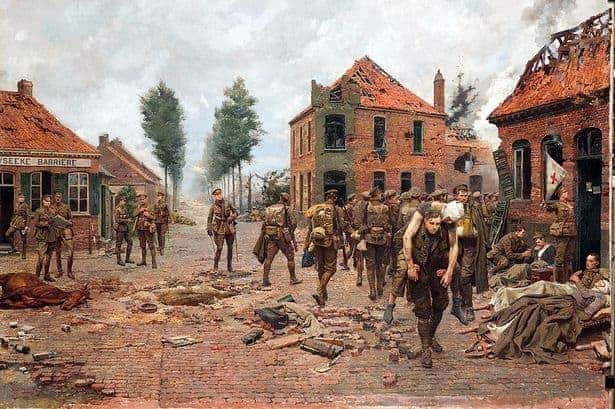In 1923, the 2nd Battalion of the Yorkshire Regiment – better known as The Green Howards – commissioned Italian war artist, Fortunino Matania to paint a picture of an episode from the regiment’s history during the First World War. The painting, “The Menin Crossroads” depicts a lull during the Battle of Ypres on the afternoon of October 22, 1914. Some named members of The Green Howards appeared in the picture. At the forefront of the painting, shown carrying a wounded man across his shoulders, was one of those men: Private Henry Tandey.
Henry Tandey was a remarkable man. In the last year of the war, his superiors awarded him no fewer than three medals for bravery, making him the most decorated British private soldier of the First World War. Tandey’s tenacity, courage, intelligence and leadership skills should have ensured him a place in the military hall of fame. However, it is likely that his name would have been mostly lost to history if Adolf Hitler had not claimed Tandey had spared his life during the battle that won Tandey the Victoria Cross. It was a claim that has haunted Tandey’s reputation. But is it true?

The Life of Henry Tandey
Henry Tandey’s was born on August 30, 1891, the son of former soldier James Tandey, in Leamington Spa, a town in Warwickshire. The young Tandey spent some time in an orphanage and after leaving school worked for a while as a boiler stoker. Then in August 1910, the nineteen-year-old joined the British Army. For four years he served with his regiment, The Green Howards in Guernsey and South Africa. Then the First World War broke out.
Over the course of the war, Tandey proved himself a real hero. He participated in the Battle of Ypres, the Battle of the Somme and the Battle of Passchendaele. However, it was in 1918 that his heroism was truly appreciated. In August 1918, during the Second Battle of Cambrai, Tandey, with two comrades, dashed into no man’s land to bomb a German trench and returned with twenty German prisoners. This bravery earned Tandey the Distinguished Combat Medal. The following month, he once again braved heavy fire at Havrincourt, taking yet more prisoners and gaining the Military Medal as a result.
Tandey’s crowning moment came when he was awarded the Victoria Cross for “conspicuous bravery and initiative during the capture of the village and the crossings of Marcoing and the subsequent counterattack” on September 28, 1918. Tandey and his regiment, the 5th Battalion of the Duke of Wellington were involved in fighting at Marcoing in France. Under heavy fire, Tandey led a Lewis gun team to take out the German position. He and his men were later surrounded by the enemy while restoring a bridge. However, Tandey led the men in a bayonet charge that broke the German ranks, saving his small company and scattering the enemy.

As the Germans fled, Tandey noticed a wounded German soldier in his line of fire. The man was so resigned to dying that he did not even raise his rifle. “I took aim,” Tandey later recalled, “but couldn’t shoot a wounded man. So I let him go.” Mercy was a policy that Tandey had apparently implemented throughout the war. The German soldier simply nodded in thanks and left.
On December 14, 1918, a picture of Private Tandey appeared in The London Gazette, which was reporting his receipt of the Victoria Cross. The following year, on December 17, Tandey was formally decorated by King George V at Buckingham Palace. He must have believed the attention to his wartime exploits was now over. Tandey remained in the army and resumed his duties. He was promoted to Sargent, but on January 5, 1926, he retired. Tandey returned to his hometown of Leamington, married and spent the next thirty-eight years as the chief of security at Triumph motors. However, in 1938, the peace of his life was shattered with a revelation from his military past.

